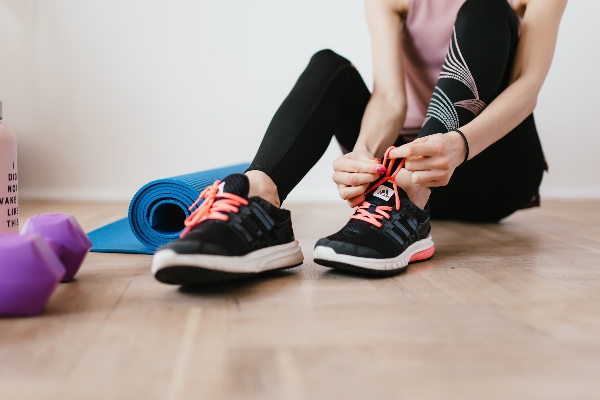Teaching aerobic dance for 30 years and counting
By Kelly A. Goff
From the first, Phyllis Patterson was hooked. It all started in 1974 after she graduated from college, when she attended a Jacki Sorensen Aerobic Dancing class with a couple of friends. “The first night we were in the back row,” recalls Patterson. “I liked the music and movement so much that I moved to the front row the second night and my friends stayed behind.” After taking aerobic dancing classes for two years, Patterson moved to the front of the class … permanently. She became a certified instructor and hasn’t looked back for 30 years.
“There was nothing else like it at the time,” says Patterson. “It wasn’t like it is now with 24-hour gyms and a big variety of fitness classes from which to choose.”
Fitness with a twist
In fact, when Patterson caught the aerobic dancing fever, the program was still in its infancy, having only been developed and introduced in 1969 by Jacki Sorensen. At the time, Sorensen’s husband was in the U.S. Air Force, and they were stationed in Puerto Rico. With a broad background in dance and a talent for teaching non-dancers, Sorensen taught all forms of dancing to dependents at Officer’s Wives Clubs on various Air Force bases.
At that same moment in time, an Air Force exercise physiologist, Kenneth H. Cooper, M.D., had published the book, Aerobics. The book was a result of his quest to find out why some seemingly fit, muscular people had difficulty running, swimming or biking. His research focused on measuring sustained human performance in terms of the ability to utilize oxygen. In 1970, he published, The New Aerobics that solidified his place in history as the father of aerobics.
Jacki Sorensen knew about Cooper’s research and wanted to see if her dancing was keeping her cardiovascular system healthy. She took his bicycle ergometer test, and her high score reinforced her belief that dancing was just as good as running when it came to staying fit. Aerobic dancing was born when she was asked to develop a television fitness program for Air Force wives. She choreographed a set of vigorous dances to upbeat music. After moving to New Jersey, she introduced the concept at a YMCA, and instantly it became popular. Today, Jacki Sorensen fitness programs are offered throughout the U.S. and Puerto Rico, as well as Australia, Japan, Vietnam and Russia.
Then and now
For the past 30 years, Phyllis Patterson has kept aerobic dancing alive and kicking in San Antonio. She’s seen the rise and fall of Jane Fonda and Richard Simmons in the 1980s, noted the ’90s popularity of Billy Blanks TaeBo (aerobic kickboxing) and has added strength training to her own fitness regimen. But throughout it all, Patterson has remained enthusiastically faithful to aerobic dancing.
“Music motivates me like nothing else,” says Patterson, who teaches five, one-hour classes each week at the Jewish Community Center. She quotes the founder, “Aerobic dancing whispers exercise but shouts lots of fun. It’s dancing for non-dancers.”
Aerobic dancing classes last one hour. The first 30 minutes are dedicated to flexibility and stretching, warming up the body for the next half hour, which is a cardiovascular workout using choreographed dance steps led by an instructor who gives cues throughout the song. Each session lasts 12 weeks and has a theme such as, “An Invitation to Dance.” It’s a progressive format, with students learning one new dance each week.
“I like that each session brings something new,” says Patterson. She and another franchise owner and instructor, Elaine Gardner, who teaches night classes, schedule a week off in between each session so they can learn the new choreography and coordinate around holidays or missed weeks. A serious testament to the popularity of class is the fact that students will schedule their own vacations or surgeries during the down week so they won’t miss any classes. Patterson has students who have been taking her class faithfully for 20 years. “When you see someone two or three times a week, you really start to share each other’s lives,” she says. “We listen to each other and offer all kinds of support and camaraderie.”
Safe and effective
Clearly the regimen is safe as Patterson has never been injured during class and to this day has no joint issues. She taught in the morning before she had her first son and did sit-ups the night before she gave birth to her second son, 21 years ago. She only took two weeks off from class with each child, coming back strong each time. One of her students marveled at Phyllis’ dedication, commenting that she took vacations that lasted longer than Phyllis’ maternity leave.
An even greater comment on the program comes from various doctors. “One of my students had hip surgery, and her doctor said she wouldn’t need any physical therapy so long as she kept coming to aerobic dancing class,” shares Patterson. “Another student with back problems had a doctor tell her he would only treat her so long as she kept coming to class.”
Aerobic dancing, like most exercise, boasts the benefit of not only being good for the heart, but also the soul.
“I’ve had women who lost a husband or child and they came to class the next day, just looking for a little escape. Others have cancer and continue to come during their treatments, doing the best they can,” says Patterson. “But we also share each other’s good times and triumphs.” A perfect example is the time Patterson sewed a bridal veil for one of her students who was getting remarried. “We made her wear it the entire class!” laughs Patterson.
Family-friendly teaching
Teaching also proved to be extremely flexible and family-friendly. She retired from her career as a speech therapist when she had children but continued to teach aerobic dancing. She switched her teaching schedule from evenings to mornings.
“When my boys were babies, I would just bring them to class with me because the gym offered babysitting. I hated to give up my boy’s last morning bottle because I knew exactly how long it would take him to finish it before we had to leave for class in the morning!” she remembers.
She tried to learn her routines while the children were napping, but sometimes they just didn’t cooperate. When her first son Clint was a baby, she used to learn the routines while he played in his crib. “I’d jog three steps forward to his crib and jog three steps back. It’s so much easier to learn the dances when the kids aren’t around,” she laughs. “I was fortunate that my husband had his own legal practice because he drove the kids to school in the morning so I could teach. He was such a trooper all those years that when my second son Sam graduated from high school, we did a little presentation to thank ‘Driver Dad.'”
During one vacation when the family rented a RV, Patterson remembers going to the back of the vehicle and thinking through the dances so she wouldn’t forget the routine by the time she got back. “I’m sure the people driving by thought I was having spasms of some sort. I like to tell people I’ve danced across the country,” she says with a wink.
Fringe benefits
The benefits that have come with teaching aerobic dancing are numerous. Not only was Patterson able to forge a balance between family and career, but also her children witnessed a daily dedication to fitness. As a result, both of her boys are athletic and enjoy sports of all kinds. Fitness has brought the family together with regular golf games and now family golf trips. Her youngest son is so sports-minded that he’s currently the men’s basketball team manager at Baylor University and is working on becoming a basketball coach.
“My father grew up on a farm and felt strongly that the key to a healthy body was exercise,” says Patterson. “That philosophy rubbed off on me. Plus with aerobic dancing, I’m constantly challenged, encouraged and inspired by my students. I’ve never dreaded going to work; instead I wake up excited to teach. I tell my students, I don’t know if you were nice before aerobic dancing or if it’s the dancing that made you nice. Either way, I’m glad you’re all here!'”






